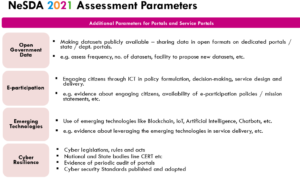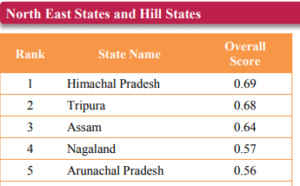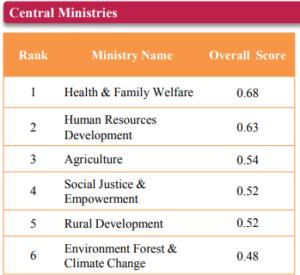Background
While there have been many successful initiatives undertaken by Central Ministries and State /UT Governments to improve overall e-Government development, it was also necessary to evaluate the overall efficiency of service delivery mechanism from a citizen’s perspective. The study was formulated to bridge this gap and help cater to a common evaluation framework that is built on global standards which could measure the depth and efficiency of existing e-Governance service delivery mechanisms of the nation. Thus the National e-Governance Service Delivery Assessment (NeSDA) framework was conceptualized and launched in August 2018.
About National e-Governance Service Delivery Assessment 2019
- By: Department of Administrative Reforms & Public Grievances, Ministry of Personnel , Public Grievances and Pensions . NASSCOM also collaborated in preparing the index
- The initial framework of NeSDA was based on the Online Service Index (OSI) of UNDESA eGovernment Survey and customized for the Indian federal structure and eGovernance landscape of the States and UTs.
- The State/UT portals were assessed only on Accessibility, Content availability, Ease of Use and Information Security & Privacy parameters.
- The State’s/UT/Central Ministries Portals’ and Service Portal’s performance across sectors were further classified based on their adherence score into Top Performers, Leaders, Aspiring Leaders and Emerging Leaders.
Parameters
The NeSDA framework primarily assessed all the service portals (State/UT and Central Ministry service portals) on 7 key parameters, viz. Accessibility, Content Availability, Ease of Use, Information Security & Privacy, End Service Delivery, Integrated Service Delivery and Status & Request Tracking.
Additional parameters

Sectors covered
- The framework covers six sectors, viz. Finance, Labour & Employment, Education, Local Government & Utilities, Social Welfare (including Agriculture & Health) and Environment (including Fire) sectors
- The framework covers services under G2B (especially to small businesses) and G2C segments, in these six sectors.
Central Ministries covered
- CBDT, Ministry of Finance (Central Board of Direct Taxes)
- Labour & Employment
- Human Resource Development(Ministry of Education)
- CBIC, Ministry of Finance (Central Board of Indirect Taxes and Customs
- Rural Development
- Social Justice & Empowerment
- Health & Family Welfare
- Agriculture
- Environment, Forest & Climate Change
Ranking of portals of states



The assessment was aimed at improving the overall e-Government development by evaluating the efficiency of service delivery mechanism from a citizen’s perspective.
















